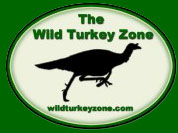|

Turkey
Biology and Behavior: Social Structure and Behavior
By T.R. Michels, Trinity Mountain Outdoors
Social Structure
Turkeys habitually occur in flocks.
Hens and young of the year often stay together throughout
the summer in family groups or flocks of several families,
with an older hen as the dominant bird of each family,
and possibly of each group. In the fall young males
or "jakes" form their own flocks and stay
together through the winter. These groups of jakes
may join adult males in the spring, during the breeding
season. Adult male flocks form in the summer after
the breeding season and remain together until spring,
when some toms go off by themselves. But, males may
form small groups of two or more birds during the
breeding season. I have seen as many as six toms in
one group. Several groups of gobblers may form an
alliance and fight other groups of gobblers for dominance
and breeding rights. Since dominance is established
within each family as the young birds grow, and the
male siblings of each family often stay together into
adulthood, the dominant male of each group is often
the sibling of the other males in the group.
Winter Behavior
During the winter turkeys separate
into flocks of different sexes and age groups; the
old and young hens remain in their own flocks, the
jakes in other flocks, and the toms in yet other flocks.
This flocking instinct is strong in most grazing animals
that depend on their ability to see and hear for defense.
Because they spend so much time eating they can't
always be on guard. Therefore, the more animals there
are together, the more time each one can spend eating
while others watch; there is security in numbers.
Spring Behavior
With the approach of spring the weather
gets warmer, daylight hours become longer and turkeys
get the urge to mate. The jakes may join the toms
and begin forming small groups that search for hens.
Both the jakes and toms begin to associate with the
hens as they all look for new spring growth, succulent
grasses, forbes and insects that appear near stream
beds and on south facing slopes that warm up first.
They look for leftover agricultural crops, mast crops
of nuts and acorns, and pick through cow chips, cattle
feeding areas, and old and new plowing for insects
and leftover food. Where turkeys inhabit hilly or
mountainous terrain they may even change home ranges,
seeking higher elevations as snow depth decreases
and new forage becomes available. They may travel
from as little as a quarter mile, to as many as several
miles between their winter and spring range.
Daily Activity
Turkeys normally roost in trees at
night, wake up about an hour before daylight, begin
calling about a half-hour before daylight, and fly
down from their roost from a half-hour to ten minutes
before daylight. Once they are on the ground they
usually look for food. If they land in wooded areas
they may look for nearby food; they generally move
to an open feeding area within a half hour. Whether
they are in wooded, shrub or open areas they search
for seeds, nuts, grasses, forbes and small insects
on the ground.
I've seen a wintering flock of turkeys
spend four hours in a cornfield in early spring, prior
to the breeding season. However, the normal amount
of time spent by large flocks or groups feeding in
open areas is about an hour to an hour and a half.
Then they move to a new opening or into the woods.
During mid-day the turkeys may loaf in wooded areas
and fly up to roost. They generally begin to feed
again in the late afternoon, and fly back up to roost
at about sundown.
This article is an excerpt from the
Turkey Addict's Manual, by T.R. Michels.
T.R. Michels is a nationally recognized
game researcher/wildlife behaviorist, and outdoor
writer and speaker, who has been studying game animals
for several years. He is the author of the Whitetail,
Elk, Duck & Goose, and Turkey Addict's
Manuals. His latest books are the 2002 Revised
Edition of the Whitetail Addict's Manual, the
2002 Revised Edition of the Elk Addict's Manual;
and the 2002 Revised Edition of the Duck &
Goose Addict's Manual.
For a catalog of books and other
hunting aids contact:
T.R. Michels, Trinity Mountain Outdoors,
PO Box 284, Wanamingo, MN 55983.
|

